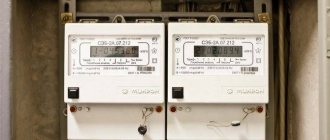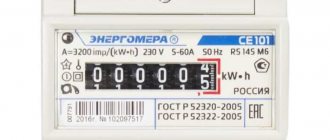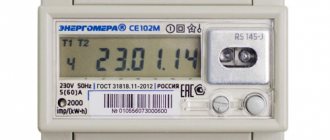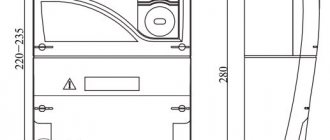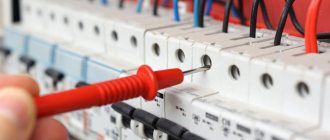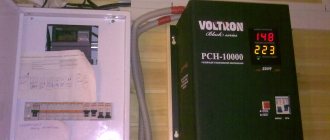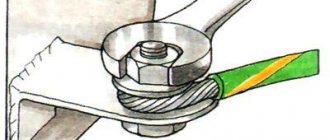As a rule, for residents of an apartment building, meters are under the control of the management company. This is their area of responsibility, which when purchasing an apartment becomes yours. Then the apartment owners can manage the meters at their own discretion: maintain an account, change the old meter for a new one, etc. And of course, the first question when buying a new electric meter, which arises regardless of the place of use (apartment or private house), is which meter is better to choose? We will answer this question and help you understand the situation.
Which counter is better
What to do if a person is electrocuted? Everyone should know this, everyone should read it!
Which meter is better for an apartment
Which meter is better for an apartment
These metering devices are divided by design.
The induction meter was invented quite a long time ago and until recently it had no competitors. It looks like a disk drive that stands on the site or right in the apartment. There are two magnetic coils inside the device: a current coil and a voltage coil. The rotating disk generates a magnetic field, this activates the counting mechanism, which takes into account the kilowatts used.
Induction meter A characteristic feature of an induction meter: reliability and long service life. According to the passport, it should work for 15 years, but in reality these “electricity accountants” can work for 30-50 years. However, in terms of measurement accuracy, the induction meter is rather weak. It only takes into account large loads and lets through weak ones.
Electronic counter . This type of meter appeared relatively recently and is capable of measuring flow directly. It does not contain moving measuring parts; flow data is shown on an indicator board. An electronic recorder stores and transmits consumption figures in automated systems such as “smart home”. In addition, modern devices are able to calculate energy consumption at several tariffs with high accuracy, which, moreover, can be increased.
Everything is taken into account, even the most minimal load from equipment in sleep mode.
Manufacturers guarantee that such a meter will work for at least 10-15 years, but in fact, no one has yet achieved such a long service life. In general, the device is reliable, sometimes there are failures, but if everything is done well in terms of electronics, the induction meter will work without interruption.
Single-phase or three-phase meter for an apartment
Since electrical networks are single-phase, with a voltage rating of 220 V, and three-phase, with a voltage of 380 V , meters are produced in different types.
Single-phase meter (which meter is better)
Most apartment residents have a single-phase meter Household electrical networks are usually designed for 220 Volts, as are home electrical appliances. But, if the apartment has a single-phase network, then most likely a three-phase meter will be superfluous here. Theoretically, if installed, it will keep track of electricity correctly. But the energy sales organization will simply refuse to register it.
Which wires are best to use for wiring in an apartment. Great comparison article here.
Three-phase meter (which meter is better)
A three-phase meter is usually used in a private home (which will be discussed later). The fact is that in a private house, much equipment (boilers, water heaters, electric motors) runs on a three-phase network with a voltage of 380 V. There is also a 220 Volt electricity meter in the house to calculate the consumption of a single-phase network. This means controlling lighting, working irons, kettles, washing machines, TVs, etc.
Three phase meter
Previously, all metering devices were induction and single-tariff. With the advent of electronic meters, it became possible to count consumed electricity at several tariffs: two, three or more.
Multi-tariff recorder (which meter is better)
The multi-tariff recorder can calculate consumption by time. This is very convenient - two tariffs for the day zone - from 7 am to 11 pm and for the night zone - from 11 pm to 7 am.
This is due to the fact that daytime energy is more expensive than nighttime energy, so it is more economical to schedule the operation of energy-intensive equipment at night. But the difference in day and night tariffs is large in some aspects, but in others it is practically non-existent, but a multi-tariff meter is always more expensive than a single-tariff meter.
It’s better, before choosing the best meter for you, to estimate the payment at several rates - the monthly consumption and break it down into days/nights. And calculate according to one tariff. If the savings are half of the single-tariff payment or at least a third, then it makes sense to install a multi-tariff device. Such a device will pay for itself and save your money.
If the difference is only 100-200 rubles, then there is no point in getting hooked on a multi-tariff payment system. The equipment will not pay for itself soon, and the savings are purely symbolic. In this case, it is better to think about smart energy management.
A multi-tariff electricity meter must be purchased for your home, taking into account consumption and equipment with powerful electrical equipment. If you have a water heater or partial electric heating, then it is more profitable to make the most of them at a cheap nightly rate.
By accuracy class
Meter accuracy class
Electric meters differ not only in design and number of tariffs, but also in accuracy class. Like any device, they have a maximum measurement error. In this case it is called the accuracy class.
According to modern requirements, an electric meter in an apartment or house must have an accuracy class of 2.0 or lower.
That is why they are forced to change old induction devices, which have an accuracy class of 2.5%. And the meaning here is this: the higher the error indicator, the more the device will miss a weak load and will not count it. For example, numerous home electrical appliances are in standby or sleep mode some of the time. The energy consumption is small, but it is still there. A meter with a lower error (1-2%) will calculate such consumption, but a meter with a high error (2.5%) will simply not notice it. This is of course beneficial for the consumer, but somehow not so much for energy sales. This turns out to be a significant undercount.
On the other hand, if you mix up the meters and use a device with an accuracy class of 0.2% instead of two, you will get inflated flow readings. Only energy sales will benefit from this.
The best single-tariff electricity meters
The choice of single-tariff devices is simply huge, but finding good electric meters in all this variety is not so easy. We have tested 40 different models so that you can install the highest quality and most accurate device that will not let you down in operation and will allow you to save a significant part of your family budget.
Energomera CE 101 R5.1 145 M6
If you need a good electricity meter for your apartment, we advise you to take a closer look at the Energomera CE 101 device. The device can be called successful in terms of the combination of price and quality, thanks to which it is incredibly popular among owners of both apartments and private houses. The model works stably, preventing loss of readings even during light outages. This is especially true if you choose a device for a summer house or garage. The Energomera electric meter is not afraid of low temperatures, which expands the possibilities for choosing where to install it. The device is secured using three screws. According to the seller's warranty, the device will serve you for about 30 years.
Advantages:
- Long warranty;
- Low price;
- Reliable design;
- Large numbers;
- Modest dimensions.
Flaws:
- Lack of digital metering board;
- Poor mounting method.
Mercury 202.5 5-60A/220V class 1.0
The single-tariff meter Mercury 202.5 rightfully takes its place in this rating; a modern device with a classic design meets all customer requirements. Judging by the reviews, the device can operate at low temperatures and high humidity (-45/90%). The device has a technological reserve for the accuracy class, which guarantees the accuracy of the readings. The technology of the device includes a shunt for measuring current, and the pulse output allows the meter to be used both autonomously and in an ASKUE system.
The manufacturer guarantees continuous operation of the device for 30 years. It is also worth noting the modest overall dimensions and low weight. For such a low cost, you will receive a properly working electric meter, which can be installed either on the landing or in an unheated cellar.
Advantages:
- Low cost;
- Mechanical indication;
- High accuracy of readings;
- The device can be installed independently;
- Durability.
Flaws:
Sometimes there are factory defects.
Easy to use, the Mercury 202.5 counter will appeal to those who are looking for a modern device that performs its direct functions. Of course, the device does not support many options, but it is ideal for installation in a country house or garage.
Electricity meter for a private home
produces equipment "Mercury™" - this is a well-known brand, with a basic accuracy class of 2.0. The products are of high quality, reliability and affordable price.
A quick and proven method from experts on how to connect an outlet
Single-tariff electronic meter Mercury series 201 and 202
The cheapest model 201.5 costs less than 1000 rubles. Its maximum current is up to 60/80A, and the model is also perfect for city apartments. The device has a 6-year warranty, the service life promised by the manufacturer is up to 30 years. In addition, the verification interval is 16 years. And this is a very important indicator. By installing a single-tariff Mercury meter, you will save yourself from headaches in terms of verification and claims by energy sales for a decade and a half.
Mercury counter
Episode 201 Counter Mercury
Mercury counter
Three-phase meter Mercury for a private home
Three-phase meter Mercury for a private home
It has an accuracy class of 1.0 and a verification interval of 10 years. To take into account active energy, single and multi-tariff meters of the 230 and 231 series are suitable. To take into account the active, reactive and total load, devices of the 230, 234, 236 series and the AR series are useful.
Electric meters Energomera
Electric meters Energomera
Produced at electrical plants of the same name. The company has been operating for more than 20 years. Its products have passed the reliability test “excellent”. Basic accuracy class 1.0, calibration interval 16 years, warranty 5 years and service life up to 30 years.
The best manufacturers of sockets and switches for your home. TOP most purchased according to buyers
They keep track of active electricity at a maximum current of 60/100A. Designed for 220 thousand operating hours. The design includes a measuring shunt, which ensures high accuracy and resistance of the device to electromagnetic interference. Meters of the CE 101 are available in different housing options: for mounting on a DIN rail, and on a plane for bolts.
Rating of the best electricity meters, top 10 most popular
Which counter is better
INCOTEX Mercury 201.5 (which meter is better)
(from 625 rubles)
INCOTEX Mercury 201.5
It is one of the most popular models on the Russian market of electric meters. This electric meter will be sold “on every corner”: in a hardware store, at the market or in a small department. The price is ideal for an apartment device. The device consists of plastic, but it is not particularly durable. That is why the manufacturer warns that it is intended for indoor use and where there is protection from environmental influences. That is, in cabinets and panels. Energy is measured digitally. The composition does not contain magnetically sensitive elements. Thus, any intentional or accidental impact on the devices with a magnetic field will not damage or break the metering device. The device is compact, mounted on a DIN rail - it is a cheap steel die, which, depending on the size, costs 15-50 rubles in a construction site.
Characteristics
- Electromechanical, accuracy class 1.0,
- DIN rail mounting,
- rated current 5 A,
- maximum current 60 A,
- minimum frequency 50 Hz, maximum frequency 51 Hz,
- included in the state register, two-wire connection, direct.
Pros: easy to find
Cons: difficult to install
Energy meter CE 101 R5.1 145 M6 (which meter is better)
Energy meter CE 101 R5.1 145 M6
Another very common domestic device. Quite popular among developers due to its low price. You can also often find it in stores. With a small-sized case, there are no installation features: it is important that there is a flat wall and a DIN rail. The device is certified and entered into the state register. In general, if you have a simple single-phase tariff, you can safely purchase this type of meter. It is important to note that the company has two models under this name. The first one is distinguished by a mechanical screen: cells with numbers. The second one has a liquid crystal display - like an electronic watch. This one costs more. And they differ only in appearance. There is a belief that a digital screen protects from electromagnetic fields. In fact, even with a conventional display, the device is protected according to all standards. We also note a good warranty on the devices - seven years.
Characteristics
- Electromechanical, accuracy class 1.0,
- DIN rail mounting,
- rated current 5 A, maximum current 60 A,
- minimum frequency 47.5 Hz, maximum frequency 52.5 Hz,
- included in the state register, two-wire connection, direct.
Pros: not noisy
Cons: the warranty is valid if you keep the box
Typeit NEVA MT 124 AS OP (which counter is better)
Typeit NEVA MT 124 AS OP
This is not only a household electricity meter. This meter can also be installed at an industrial or social facility. There are regulatory documents for this. Has intelligence in the ability to calculate energy consumption at different times of the day, when connecting to the appropriate tariff. The device is neat and not bulky. The readings are clearly visible on the LCD display. In case of power outages, you will need a CR2450 battery - “washer”. However, it can be easily replaced without opening the case. The capacitor is installed by the manufacturer. The device's memory stores daily values and readings for 128 days. There is also an electronic seal available. It is a sensor that records unauthorized opening in the device memory. According to the law, a regular seal will have to be placed on the device in any case. The display can display energy consumption at the end of the month according to tariffs. Similar figures for the previous 16 months are stored in memory.
Characteristics
- Electromechanical, accuracy class 1.0,
- DIN rail mounting,
- rated current 5 A,
- maximum current 60 A, minimum frequency 47.5 Hz, maximum frequency 52.5 Hz,
- included in the state register, two-wire connection, direct.
Pros: compact
Cons: need to keep an eye on the battery
INCOTEX Mercury 200.02 (which counter is better)
INCOTEX Mercury 200.02
An electric meter with the possibility of two-tariff measurement of indicators has a very reasonable price compared to others. It can easily be included in the list of the best electricity meters. You can even ask the electric company to switch you to a split charging plan. In this case, at night the cost of a kilowatt will cost nothing, but during the day the price goes higher. It is convenient when people wash or cook with such a tariff only in the evening. In addition, this counter can immediately transmit data to ASKUE. This concept stands for an automated system for collecting evidence. In Russia, such a thing exists only in modern new buildings, in which they decided to take care of energy efficiency. For others, the bells and whistles will be useless. The structure includes a display on which you can display some data, in particular such as information on expenses for the past month.
Characteristics
- Electromechanical, accuracy class 1.0,
- DIN rail mounting,
- rated current 5 A, maximum current 60 A,
- minimum frequency 49 Hz, maximum frequency 51 Hz,
- included in the state register, two-wire connection, direct.
Pros: functionality
Cons: there are complaints about reliability
TDM ELECTRIC MARS-1.0-11-SH-M SQ1105-0008 (which meter is better)
TDM ELECTRIC MARS-1.0-11-SH-M SQ1105-0008
Unlike previous electricity meters of 2021, this model has a more bulky, although nice, appearance. It looks neat, streamlined, the body is made of good light plastic, plus the use of non-flammable materials. So, in appearance he is quite. So that the device meets the technical aesthetic requirements. Suitable not only for home, it can even be installed in public places and industrial enterprises. The company uses the polymer from which the column with terminals is made - polybutylene terephthalate. What makes this material special? The main thing is greater confidence in the reliability of the device’s contacts. Note that a sealing rubber is installed in the case; it provides protection according to the IP51 . This is good protection against dust, and mediocre protection against water - literally from drops.
Characteristics
- Electromechanical, accuracy class 1.0, DIN rail mounting, rated current 5 A, maximum current 60 A, maximum frequency 50 Hz, included in the state register, two-wire connection, direct
Pros: appearance and quality of materials
Cons: Available only in a couple of stores
Typeit NEVA 103 1S0 230V (which meter is better)
Typeit NEVA 103 1S0 230V
Another budget device from a St. Petersburg company that specializes in the production of electric meters. This is the simplest device possible. It's even assembled in such a way that it can't be taken apart. This is good from a device security point of view. This device is mostly suitable for home use: in an apartment, cottage or garage. But the specifications indicate that it can also be used to account for consumption in public buildings. In addition to the mechanical display, there is an LED that serves as an indicator of proper operation and flickers in proportion to the amount of energy consumed. Just in case, let’s clarify that it blinks quite often. Therefore, if the device is located somewhere in an open area, and you are annoyed by various flashes, even small ones, then you will have to tape it up or hide the counter in a closet.
Characteristics
- Electromechanical, accuracy class 1.0,
- DIN rail mounting,
- rated current 5 A, maximum current 60 A,
- minimum frequency 47.5 Hz, maximum frequency 52.5 Hz, included in the state register,
- two-wire connection, direct.
Pros: price/quality
Cons: flickering LED
EKF SKAT 301M/1 R PROxima (which meter is better)
EKF SKAT 301M/1 R PROxima
The most advanced and reliable electricity meter on the Russian market. It has good quality that is worth good money. Equipped with protection against increased input voltages and impulse noise. However, if everything is fine with the wiring in the house, then the loads that the device is capable of accepting are unlikely to be needed in everyday life. The declared service life is at least 30 years. Standard period, which is also indicated by other manufacturers. Only the verification interval of the device is indicated in the passport. And since the verification procedure is not cheap, it will be cheaper to buy a new device. The factory warranty is only five years. Despite the fact that the model is innovative, the dimensions and locations of the seats coincide with the location of the mounts on the old meters. This means that there should be no problems with installation. A DIN rail or mounting platform will help - the price is about 150 rubles.
Characteristics
- Electromechanical, accuracy class 1.0,
- DIN rail mounting,
- rated current 5 A, maximum current 60 A,
- maximum frequency 50 Hz,
- included in the state register,
- two-wire connection, direct.
Pros: leading quality indicators among analogues
Cons: high price
Energy meter CE 101 S6 145 M6 (which meter is better)
Energy meter CE 101 S6 145 M6
Its analogue was mentioned above. It takes its rightful place in the ranking of the best electricity meters. Honestly speaking, compared to other electricity meters from this company, there is not much difference. Unless, as of 2021, this device is actually newer. The case uses more durable plastic, there is contact protection so that the connected wires do not stick out. The device is one-tariff, without any tricks. The reading device is mechanical, and behind frosted plastic glass. There is a light inside it that lights up if everything is normal with the device. At the same time, it does not consume a lot of electricity. The device is better than a cheaper analogue from the same line, for which we must say “thank you” to the new case. Possesses protection from environmental influences. The class of protection against dust and moisture is not specified. If you use it carefully at home, you don’t have to hide the case anywhere; everything will be fine.
Characteristics
- Electromechanical, accuracy class 1.0,
- DIN rail mounting,
- rated current 5 A, maximum current 60 A,
- minimum frequency 47.5 Hz, maximum frequency 52.5 Hz,
- included in the state register,
- two-wire connection, direct
Pros: reliable
Cons: distinctly noisy, sometimes clicking
INCOTEX Mercury 201.7 (which counter is better)
INCOTEX Mercury 201.7
Also an inexpensive device for 2021. The body is made of budget plastic. Materials similar to the cheap Chinese toys sold in markets in the recent past. Although, this does not affect the accounting characteristics in any way. The device regularly keeps a chronology of electricity consumption. Only during installation, you need to be extremely careful when handling the case so as not to accidentally split the case with a tool during installation. It is better to place this electric meter behind a protective cabinet, it is more reliable. The device is certified and included in the state register for use in homes. The device is resistant to magnetic fields. Thanks to the anti-reverse mechanism, the numbers do not rotate in the opposite direction. The housing cannot be disassembled and reassembled independently. An attempt to open it will destroy it and restore its integrity, and it will also not be possible to put a seal.
Characteristics
- Electromechanical, accuracy class 1.0,
- DIN rail mounting,
- rated current 5 A, maximum current 60 A,
- minimum frequency 50 Hz, maximum frequency 51 Hz,
- included in the state register,
- two-wire connection, direct.
Pros : simple design
Cons : fragile
Typeit NEVA 101 1S0 230V (which meter is better)
Typeit NEVA 101 1S0 230V
The outside of the device is made of a strong plastic case. It has installation flexibility compared to other models of the best electric meters of 2021. That is, it can be screwed with three screws and can be placed on a DIN rail model TN35. The main part of the markings is applied not with paint, but with laser engraving, which means it will last better and longer. Easy connection. In addition, the law allows you to install the device yourself if you do not want to involve a specialist. But only network specialists can connect and seal it. Good equipment: the terminal block screws do not fall out - they remain in their sockets when fully unscrewed. According to the manufacturer, the connection securely fixes the wires. The presence of a flickering indicator produces light pulses based on the amount of energy consumed.
Characteristics
- Electromechanical, accuracy class 1.0,
- DIN rail mounting,
- rated current 5 A, maximum current 60 A,
- minimum frequency 47.5 Hz, maximum frequency 52.5 Hz,
- included in the state register,
- direct connection
Cons: Makes a loud clicking sound when turning the wheel
Pros: two installation options
Single-phase electricity meters
Neva 103 1SO
Single-tariff op-amp
Neva 103 1SO is a certified mechanical type device with a 7-digit readout device.
The kit includes a reverse stopper, a shunt, an LED indicator, and screw terminals. The device body is made of gray plastic. Mounted using DIN rail. High-quality latches help to install it quickly and easily. The meter meets the requirements of professionals and consumers. And also the ratio of price, quality and efficiency is excellent.
Advantages:
- The case cannot be disassembled, the mounting latch is very durable;
- Small size and weight;
- The numbers are a good size, making them easy to read;
- Accurate readings;
- High-quality fastening of wires;
- Budget cost;
- The actual service life is 30 years.
Flaws:
The discrepancy between the blinking and clicking of the indicator leads to confusion.
The average price is 425 rubles.
Mercury 201.8
Single tariff LCD
Mercury 201.8 is a modern modification device with a 7-digit LCD screen. Differs in increased operational data.
It stands out among other models by the presence of a modular housing, screw terminals and a current measuring transducer. Attaches using DIN rail. An LED backlight is installed, which allows you to take readings even in poor lighting. The model is relatively new and it is just beginning to earn leading positions.
Advantages:
- Shunt and locking latch included;
- Light weight;
- Compact dimensions;
- Easy to install;
- Durable housing;
- Accuracy class – high;
- Budget cost;
- Service life – 30 years.
Flaws:
Poor quality telemetry.
The average price is 680 rubles.
Energy meter CE102M S7 145-JV
Multi-tariff LCD economical
Energy meter CE102M S7 145-JV is a multifunctional model that is resistant to mechanical, climatic and electromagnetic influences.
Distinctive features of the device are the presence of a communication interface and non-volatile memory. Displays readings even when there is no power. A shunt is included in the package. The meter can identify data accumulated over 24 hours or a month. The model has buttons with which you can control it. The 7-digit LCD monitor has a backlight.
Advantages:
- The memory is protected from modification;
- Compact;
- Convenient to use;
- If necessary, simply reprogram;
- Service life – 16 years.
Flaws:
Not always easy to install.
Average price - 1800 rubles
Mercury 200.02
Multi-tariff LCD self-sustaining
Mercury 200.02 is a device that allows flexible accounting of electricity consumption. Using an RCD you can control the load. Installed on DIN panel. The model allows you to take readings at a maximum of 4 tariffs. The data is displayed on the screen. Information is stored for up to 11 months. With the correct distribution of the daily load on the electrical network, the device allows you to save profitably.
Advantages:
- Information about switching prices is displayed;
- Individual operating modes “summer-winter”;
- Load adjustable;
- The electrical energy used is monitored;
- Pays for itself quickly;
- Allows you to save money;
- Easy to use;
- Memory is volatile;
- Nice design;
- Active service time is 30 years.
Flaws:
- The meter is powered by the consumer;
- There is no screen backlight;
- Expensive installation.
Average price - 1950 rubles
What to look for when purchasing
If you nevertheless decide to purchase and install an electricity meter at your own expense, then pay attention to the following parameters:
- Construction type . Mechanical or electronic. Mechanical is cheaper, but less accurate. Electronic is more expensive, but more accurate and can be multi-tariff, allowing you to save in the future.
- Intervalidation interval . For a mechanical one, a good indicator is 16 years, for an electronic one – 8 – 10 years.
- Brand . Popular are Incotex (Mercury), EKF, and Taipit (Neva). On average, the price for single-phase single-tariff meters does not exceed 1000 - 1100 rubles. The price for four-phase starts from 2000 - 2500 rubles.
